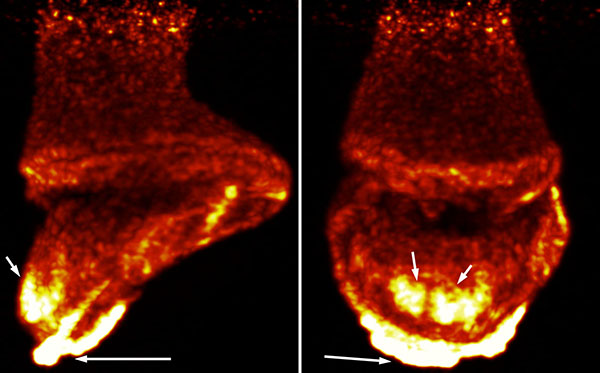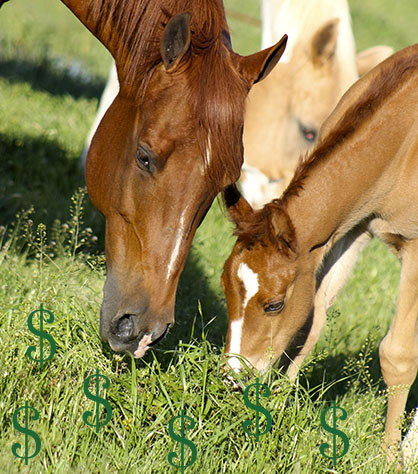AQHA Foundation Research Priorities
September 20, 2018 Comments Off on AQHA Foundation Research Priorities
1. Infectious Diseases – with priority placed on research that addresses:
Rhodococcus equi
Streptococcus equi (including subspecies equi and or zooepidemicus)
Equine herpesvirus-1 (EHV-1)
2. Equine Wellness – with priority placed on research that addresses:
Parasite resistance
3. Equine Welfare – with priority placed on research that addresses:
Competition integrity
4. All other proposals
At the Forefront of PET Veterinary Imaging
September 19, 2018 Comments Off on At the Forefront of PET Veterinary Imaging
One of this year’s most important achievements was the validation of a dual-tracer scanning protocol, which allows for the assessment of both bone and soft tissue lesions in lame horses. This protocol has now been used on several clinical cases and has been utilized to assess complex lesions involving the foot and the suspensory ligament. (Figure 1)
Continue reading …Care of the Mare and Foal During Weaning Time
September 18, 2018 Comments Off on Care of the Mare and Foal During Weaning Time
Behavioral manifestations of stress in foals are best handled by management of their environment, keeping them with familiar companions, a stabilizing adult, and confined in an area with sturdy and safe fencing. However, there are still often problems with the babies going off feed. Maintaining adequate nutrition that is without excessive calories is also an issue for mares that need to decrease milk production, but often are pregnant.
Continue reading …AAEP Foundation Equine Disaster Relief Fund Accepting Donations to Aid Hurricane Florence Victims
September 17, 2018 Comments Off on AAEP Foundation Equine Disaster Relief Fund Accepting Donations to Aid Hurricane Florence Victims
Authorities indicate that many horses are being relocated inland, putting a heavy strain on facilities and caregivers, while other horses may become stranded in flooded eastern flatlands. The predicted flood waters will make extended care for displaced animals an ongoing need.
Continue reading …What to Do About Customers Who Silently Steal Your Time And Money – No-Shows, Last Minute Cancellations, and Late Arrivals
September 17, 2018 Comments Off on What to Do About Customers Who Silently Steal Your Time And Money – No-Shows, Last Minute Cancellations, and Late Arrivals
An erratic cash flow from lesson revenue caused by no-shows and late cancellations will create stress you don’t deserve. If this is a problem for you, you can do something about it when you choose to take total responsibility for correcting the problem.
Continue reading …Western Riding Added to APHA HorseIQ Training Library
September 14, 2018 Comments Off on Western Riding Added to APHA HorseIQ Training Library
Additionally, you’ll find links to view the judges’ scorecards from the World Show event, providing you a way to compare your scores to how the judges scored the class.
Continue reading …Yearling In-Hand Trail Added to APHA HorseIQ Library
September 14, 2018 Comments Off on Yearling In-Hand Trail Added to APHA HorseIQ Library
New to the HorseIQ Library are yearling in-hand trail videos from the 2017 APHA World Championship Show. Use these videos to improve your understanding of the class judging priorities and scoring system, to practice judging and scoring each run, and to understand the nuances that compile to create a winning performance.
Continue reading …Horse Farms Forever Highlights Important Policy Updates to Marion County Plan
September 13, 2018 Comments Off on Horse Farms Forever Highlights Important Policy Updates to Marion County Plan
“Our equine industry was developed here more than 80 years ago because of the unique characteristics of the year-round moderate climate, the mineral-rich soil and water specific to the region. And, just like the Florida Keys protects its coral reefs, we must do our job here in Marion County to protect our green space that is revered as the Horse Capital of the World.™”
Continue reading …Tool Pilots Use to Save Lives Can Help You Run Your Horse Business
September 10, 2018 Comments Off on Tool Pilots Use to Save Lives Can Help You Run Your Horse Business
Here are some ideas for checklists you can create that will keep your business running smoothly:
Continue reading …ASPCA to Offer $75,000 to Support Law Enforcement Response to Equine Cruelty in FL and WI
September 8, 2018 Comments Off on ASPCA to Offer $75,000 to Support Law Enforcement Response to Equine Cruelty in FL and WI
Grants will range from $5,000 to $25,000 and will be available to organizations in Florida and Wisconsin with law enforcement authority to address equine cruelty or working in partnership with such agencies. The funding will be used to increase housing capacity and provide other resources that would facilitate the rescue, rehabilitation, and rehoming of equines from situations of cruelty and neglect.
Continue reading …







